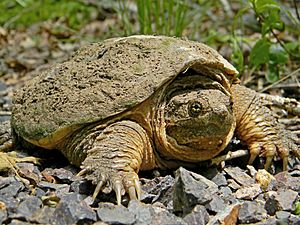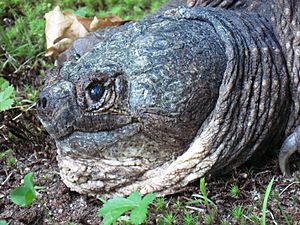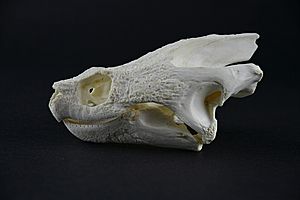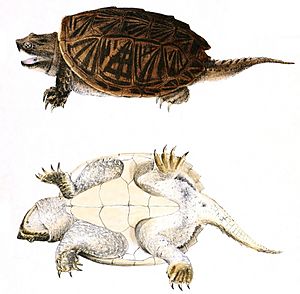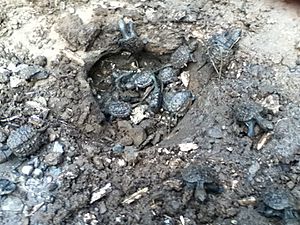Common snapping turtle facts for kids
Quick facts for kids Common snapping turtle |
|
|---|---|
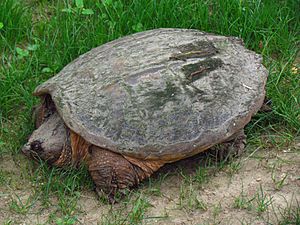 |
|
| Female searching for nest site | |
| Conservation status | |
| Scientific classification | |
| Genus: |
Chelydra
|
| Species: |
serpentina
|
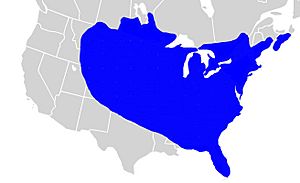 |
|
| Native range map of C. serpentina | |
| Synonyms | |
|
|
The common snapping turtle (Chelydra serpentina) is a large freshwater turtle. It belongs to a family of turtles called Chelydridae. You can find these turtles from southeastern Canada all the way down to Florida. They also live west to the edge of the Rocky Mountains. The common snapping turtle is the most common type of snapping turtle.
These turtles are known for being a bit feisty when they are out of the water. They have strong, beak-like jaws and a very flexible neck. This is why their scientific name, serpentina, means "snake-like." When they are in the water, they usually try to swim away and hide in the mud. Snapping turtles live a long time. Females in colder places might start having babies later, around 15–20 years old. In warmer areas, they might start around 12 years old. Some snapping turtles in Canada have lived for over 100 years!
Contents
- What Does a Snapping Turtle Look Like?
- Where Do Snapping Turtles Live and What Do They Eat?
- Who Hunts Snapping Turtles?
- Snapping Turtle Life Cycle and Habits
- Are There Different Types of Snapping Turtles?
- How Do Snapping Turtles Behave?
- Snapping Turtles and People
- Snapping Turtles in New Places
- Protecting Snapping Turtles
- Images for kids
- See also
What Does a Snapping Turtle Look Like?
The common snapping turtle has a strong, muscular body. Its upper shell, called a carapace, can have ridges, especially when the turtle is young. Adult shells can be about 25 to 47 centimeters (10 to 18.5 inches) long. These turtles usually weigh between 4.5 and 16 kilograms (10 to 35 pounds).
Male snapping turtles are bigger than females. Most turtles weighing more than 10 kilograms (22 pounds) are old males. The heaviest wild snapping turtle ever found weighed about 34 kilograms (75 pounds). Turtles kept as pets can get very heavy, sometimes up to 39 kilograms (86 pounds), if they are fed too much. In colder areas, the common snapping turtle is often the heaviest freshwater turtle around.
Where Do Snapping Turtles Live and What Do They Eat?
Snapping turtles like to live in shallow ponds or streams. Some can even live in slightly salty water, like in estuaries. They sometimes float on the surface of the water with just their shell showing to warm up. In colder places, they might also bask on logs in the spring.
In shallow water, snapping turtles can hide under the mud with only their heads sticking out. They stretch their long necks to the surface to breathe, using their nostrils like a snorkel. Snapping turtles eat both plants and animals. They are important "clean-up crew" members in the water, eating dead things. But they also hunt! They will eat almost anything they can swallow, like invertebrates (bugs), fish, frogs, other reptiles (even smaller turtles and snakes), birds, and small mammals. Sometimes, they might catch ducklings or goslings, but this is not as common as some people think.
Who Hunts Snapping Turtles?
Adult snapping turtles have very few animals that hunt them. But their eggs are often eaten by animals like crows, American mink, skunks, foxes, and raccoons. When they are baby turtles or young turtles, they can be hunted by the same animals, plus herons, hawks, owls, large fish, and snakes. Sometimes, even river otters will hunt hibernating adult snapping turtles in Canada during winter. Other animals that might hunt adults include coyotes, black bears, and alligators. Very large, old male snapping turtles are usually safe because of their size and strong defenses.
Snapping Turtle Life Cycle and Habits
These turtles often travel across land to find new homes or to lay their eggs. They might move because of pollution, losing their habitat, not enough food, or too many other turtles. It's common to see them far from water.
Snapping turtles mate from April to November. The busiest time for laying eggs is in June and July. Female turtles can store sperm for several years and use it when they need to. Females travel on land to find sandy soil to lay their eggs, often far from water. They dig a hole and usually lay 25 to 80 eggs each year. They use their back feet to guide the eggs into the nest and then cover them with sand.
How long the eggs take to hatch depends on the temperature, usually 9 to 18 weeks. In colder places, the baby turtles might stay in the nest all winter. Snapping turtles are very good at handling cold weather. Some turtles stay active under the ice during winter instead of hibernating. When they hibernate, they don't breathe for more than six months because ice covers their hiding spot. They can get oxygen by sticking their head out of the mud and absorbing oxygen through their mouth and throat. This is a special way of breathing without their lungs.
Even though they are listed as "least concern" by the IUCN, which means they are not in immediate danger, their numbers have dropped in Canada. Because of this, they are listed as "Special Concern" there. This means their way of life is easily affected by human activities.
Are There Different Types of Snapping Turtles?
Right now, scientists only recognize one type of common snapping turtle. Some turtles that used to be considered types of common snapping turtles are now seen as their own separate species, like the Central American snapping turtle and the South American snapping turtle.
How Do Snapping Turtles Behave?
In their natural homes, snapping turtles are at the top of the food chain. This means they don't always feel scared or aggressive. If they meet something new, like humans, they might get curious. Sometimes, they might even bump their nose on a person's leg in the water. Even though they can be fierce, if a swimmer comes near them in the water, they usually swim away quietly or hide under mud or grass.
Snapping Turtles and People
Snapping Turtles as Food
The common snapping turtle has been used in turtle soup for a long time. However, eating too much of their meat can be unhealthy because they might have absorbed harmful chemicals from their environment.
Snapping Turtles as Pets
Common snapping turtles are generally not good pets. Their necks are very flexible, and a wild turtle can bite you even if you pick it up by the sides of its shell. Their claws are sharp, like a dog's, but you can't trim them. Turtles use their claws for digging and gripping, not for attacking or eating. If a snapping turtle feels threatened, it might make a hissing sound, but they usually prefer to avoid fights.
It's a common myth that you can safely pick up a snapping turtle by its tail. This can actually hurt the turtle's tail and spine very badly. Picking them up with your hands can be hard and dangerous. Snapping turtles can stretch their necks all the way back to their hind feet to bite. When they are stressed, they might release a musky smell from behind their legs.
If you see a snapping turtle on a road, it might be tempting to get it to bite a stick and drag it to safety. But this can scrape the turtle's legs and underside, leading to dangerous infections. The safest way to pick up a common snapping turtle is to hold its shell above its back legs. There's a big space there that lets you hold the shell easily and keeps your hands safe from its bite and claws. You can also use a shovel, making sure it's flat under the shell. The easiest way is to use a blanket or tarp, picking up the corners with the turtle in the middle.
Some farms in China raise snapping turtles.
Snapping Turtles in Politics
The common snapping turtle was part of a famous American political cartoon. This cartoon was made in 1808 to protest a law called the Embargo Act of 1807. The cartoon showed a snapping turtle biting a trader who was trying to take goods to a British ship. The trader was saying, "Oh! this cursed Ograbme." "Ograbme" is "embargo" spelled backward, and it also sounds like "O, grab me," which is what the turtle was doing! This cartoon is seen as an important early example of modern political cartoons.
In 2006, the common snapping turtle was chosen as the official state reptile of New York. This happened after children in elementary schools across the state voted for it.
Snapping Turtle Bite Strength
Many people believe that common snapping turtles can bite off human fingers or toes. While their strong jaws are certainly capable of doing so, there are no proven cases of this happening with this species. They usually use their size and strength to scare away animals that might try to hurt them. Underwater, common snapping turtles are actually "quite calm" and prefer to avoid fights. In 2002, a study found that the common snapping turtle's bite force was between 208 and 226 Newtons. To compare, the average human bite force is between 300 and 700 Newtons. Another type of turtle, the alligator snapping turtle, is known to have bitten off fingers, with at least three confirmed cases.
Snapping Turtles in New Places
In recent years, large adult common snapping turtles have been found in rivers and canals in Italy. They were probably released by people who no longer wanted them as pets. In March 2011, a 20-kilogram (44-pound) turtle was caught near Rome. Another one was caught there in September 2012. In Japan, these turtles were brought in as pets in the 1960s. They have caused serious bite injuries there. In 2004 and 2005, about 1,000 snapping turtles were found in Chiba Prefecture, showing how many had been introduced.
Protecting Snapping Turtles
The common snapping turtle is currently listed as "Least Concern" by the IUCN. This means they are not in immediate danger of disappearing. However, their numbers have gone down because people collect them for pets and their homes are being destroyed. Because of this, Canada and some U.S. states are putting in place stricter rules to protect them. In Canada, it's listed as a "Special Concern" species. This means there are projects to find their main habitats, understand and reduce threats to them, and teach people about these turtles.
Images for kids
See also
 In Spanish: Tortuga mordedora para niños
In Spanish: Tortuga mordedora para niños



